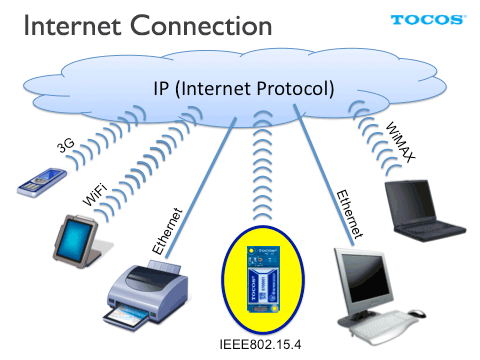Internet of Things
The Internet of Things is a technology to connect uniquely identifiable objects ("things") to the internet, where mainly, IT related devices such as a PC, server, and printer are linked.

We have already seen such trend that digital information home appliances are connected to the internet. Those appliances range from a television, digital camera, digital video camera, digital audio player, HDD player, to DVD player. We will see more and more scenes where digitalized movie, music, voice data, pictures, text information are transmitted over the internet.
So, the internet is now turning into an information transfer path for all kinds of "things" communicating each other.
It is possible to connect other home appliances such as lighting devices, air conditioner, and health care devices to the internet by transferring measuring data, sensor data, and control data, and status monitoring and remote control are also possible for the devices other than home appliances such as a water heater and bath heater. The system can also obtain the information from various sensors that are installed everywhere from in a factory, building, store, hospital, school, to outdoors.
What the concept tries to achieve is a safer, more comfortable life by installing various sensors in "things", monitoring the status over the internet, and controlling "things" through the internet.
There are two approaches to connect "things" with the internet physically; wired and wireless connection. There are many cases in the Internet of Things where wireless connection is very useful or it would not be practical to achieve a connection without a wireless method. Even now, various devices are already connected with the internet in such a wireless method that WiFi (wireless LAN), Bluetooth, and WiMAX, leading to further improved convenience.
Some "things", however, may be difficult to connect using these kinds of wireless methods. In the case of the Internet of Things, the number of "things" to be connected is extremely large, so it requires the wireless technology that can support the connection of a number of nodes in the same area. There are also many cases where it is not easy to supply the power to "things" with AC power supply. Some "things" may not allow its batteries to be replaced or charged so frequently. Therefore, what we need to make the Internet of Things work includes the wireless technology that supports devices which can operate for a long time at low power consumption on batteries or energy harvesting power supply. To allow a great number of "things" to implement wireless communications, the band to be used should be small. In addition, a security function is also important to protect the contents of communications.
As a wireless method suited for materializing the Internet of Things, there is IEEE802.15.4 established by IEEE to supplement the existing wireless methods (WiFi, Bluetooth). IEEE802.15.4 is a wireless standard to send and receive the information from sensors and control signals for a control purpose, it can operate at low power consumption and up to 65535 nodes can be connected, which makes the wireless method suitable for a wireless sensor network. It is equipped with powerful encryption functions (AES-128) as well.
To materialize the Internet of Things, we need to monitor and control "things" through the internet. In doing so, we need an ID for each individual object connected. The internet uses identifiers called IP address. Although IPv4 (Internet Protocol Version 4) can assign about 4 billion IP addresses with 32 bit, there will be no available address left someday as the "things" connected to the internet increase. The Internet of Things can even assign address to all "things" in the world because it uses IPv6 (Internet Protocol Version 6), which can assign about 340 unidecillion (340 x 1036) IP addresses with 128 bit.
There is a communications protocol called 6LoWPAN (IPv6 over Low power Wireless Personal Area Networks) developed by IETF that allows IPv6 packets to be sent to and received from over IEEE802.15.4 based networks. 6LoWPAN reads six-low-pan. 6LoWPAN enables the devices with IEEE802.15.4 mounted to connect to an IP (Internet Protocol) network. Therefore, 6LoWPAN allows the devices with IEEE802.15.4 mounted to communicate with the devices supporting wired communications (Ethernet), WiFi, Bluetooth, or 3G over the internet, thus materializing the Internet of Things.
6LoWPAN will be adopted in ZigBee IP, a next-generation ZigBee standard. The JenNet-IP that our wireless modules support has also adopted 6LoWPAN.
We are offering IEEE802.15.4 Wireless Module best suited to construct a wireless sensor network, and help you simplify the process to develop communications functions for your Internet of Things related devices and expedite the time to market
For more details on our products, please see Wireless Products.
Related Information
- What is Wireless Sensor Network?
- Communications between Devices: What is Wireless M2M Communications?
- Energy Management Systems: HEMS, BEMS, FEMS, CEMS
Wireless Products
- Overview
- Wireless Products Overview
- Wireless Engine
- TWE Lite DIP
- TWE-Lite
- TWE-REGULAR
- TWE-STRONG
- Software
- ToCoNet
- TWE-ZERO
- Evaluation, Development
- Evaluation & Development Kit
- Sensor Network Evaluation Kit
- Antenna
- Avaliable Antennae
Technical Information
- RFID
- 920MHz_vs_24
- IEEE802.15.4
- Protocol Stack
- ZigBee
- Wireless Sensor Networks
- Energy Harvesting Technology
- M2M Wireless Communications
- HEMS / BEMS / FEMS / CEMS
- Internet of Things

